Finding the right dancing shoes can be a game-changer for any man looking to step up his salsa, bachata, or any dance style. Just like having the right equipment elevates any sport, the perfect footwear can enhance your performance, comfort, and style on the dance floor. Whether you’re a seasoned pro or just starting out, understanding the nuances of Dancing Shoes For Men is crucial. This comprehensive guide dives deep into the world of men’s dance footwear, exploring various types, their pros and cons, and ultimately helping you find the best dancing shoes to unleash your inner dancer.
What to Look for in Dancing Shoes for Men
Choosing the right dancing shoes goes beyond just aesthetics. It’s about finding a balance between style, performance, comfort, and versatility. Here’s a breakdown of the key factors to consider:
Style: Your shoes are an extension of your personal style. Whether you prefer a classic, understated look or something more eye-catching, your dance shoes should reflect your personality and confidence on the dance floor.
Performance: The right shoes can significantly improve your dance technique. Look for features that facilitate smooth spins, precise footwork, and comfortable movement across the dance floor.
Comfort: Long nights of dancing demand comfortable footwear. Shoes that prevent foot fatigue, provide adequate support, and minimize strain on your body are essential for enjoying your dance sessions to the fullest.
Versatility: For many, the ideal dancing shoe can transition seamlessly from the dance floor to other social settings. Versatile shoes eliminate the need to carry extra pairs, making your dance outings more convenient.
Exploring Different Types of Dancing Shoes for Men
Just like there’s a variety of dance styles, there’s also a diverse range of dancing shoes for men. Each type caters to different needs and preferences. Let’s explore some popular options:
Dance Sneakers
Dance sneakers are a popular choice, especially for beginners and those seeking comfort and versatility. Often recommended by dance instructors, they offer a blend of athletic functionality and dance-specific features.
Pros:
- Lightweight and Durable: Similar to regular sneakers, dance sneakers are designed for agility and long-lasting wear.
- Split Sole Design: A key feature is the split sole, separating the sole into two parts – one for the ball of the foot and one for the heel. This enhances flexibility and encourages dancing on the balls of your feet, which is crucial for many dance styles.
- Smooth Outsole: Typically made of smooth materials like synthetic or suede, the outsole allows for easy spinning and gliding on various dance floor surfaces.
- Versatile for Practice and Social Dancing: Dance sneakers are suitable for both practice sessions and casual social dancing.
Cons:
- Style Limitations: While some dance sneakers are designed to be more stylish, they generally have a sporty look that might not be appropriate for formal dance events or everyday wear outside of dance settings.
- Durability for Outdoor Wear: Although designed to be durable, they are not ideal for prolonged outdoor use on rough surfaces, which can wear down the specialized soles.
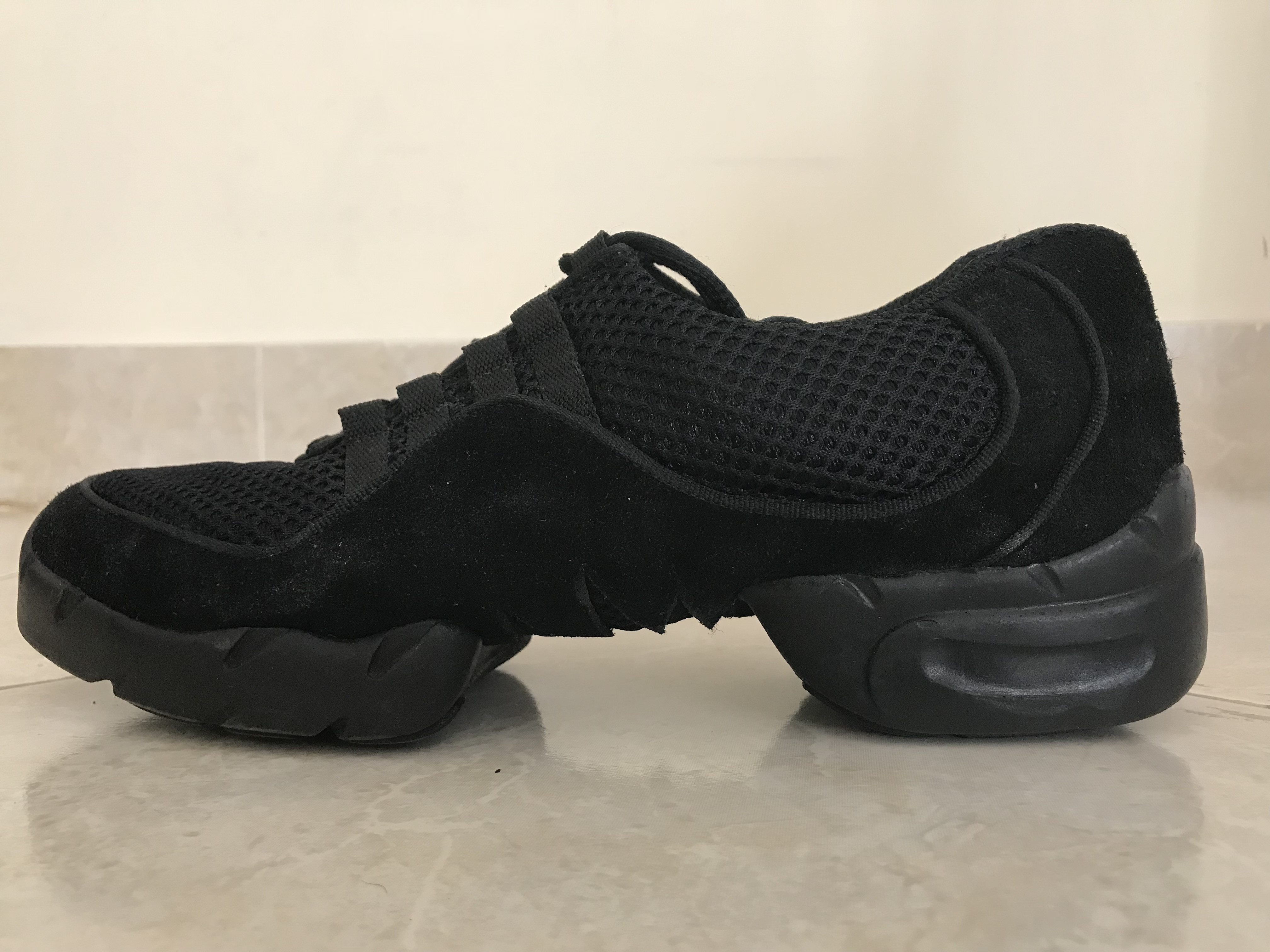 Men’s Dance Sneaker Profile
Men’s Dance Sneaker Profile
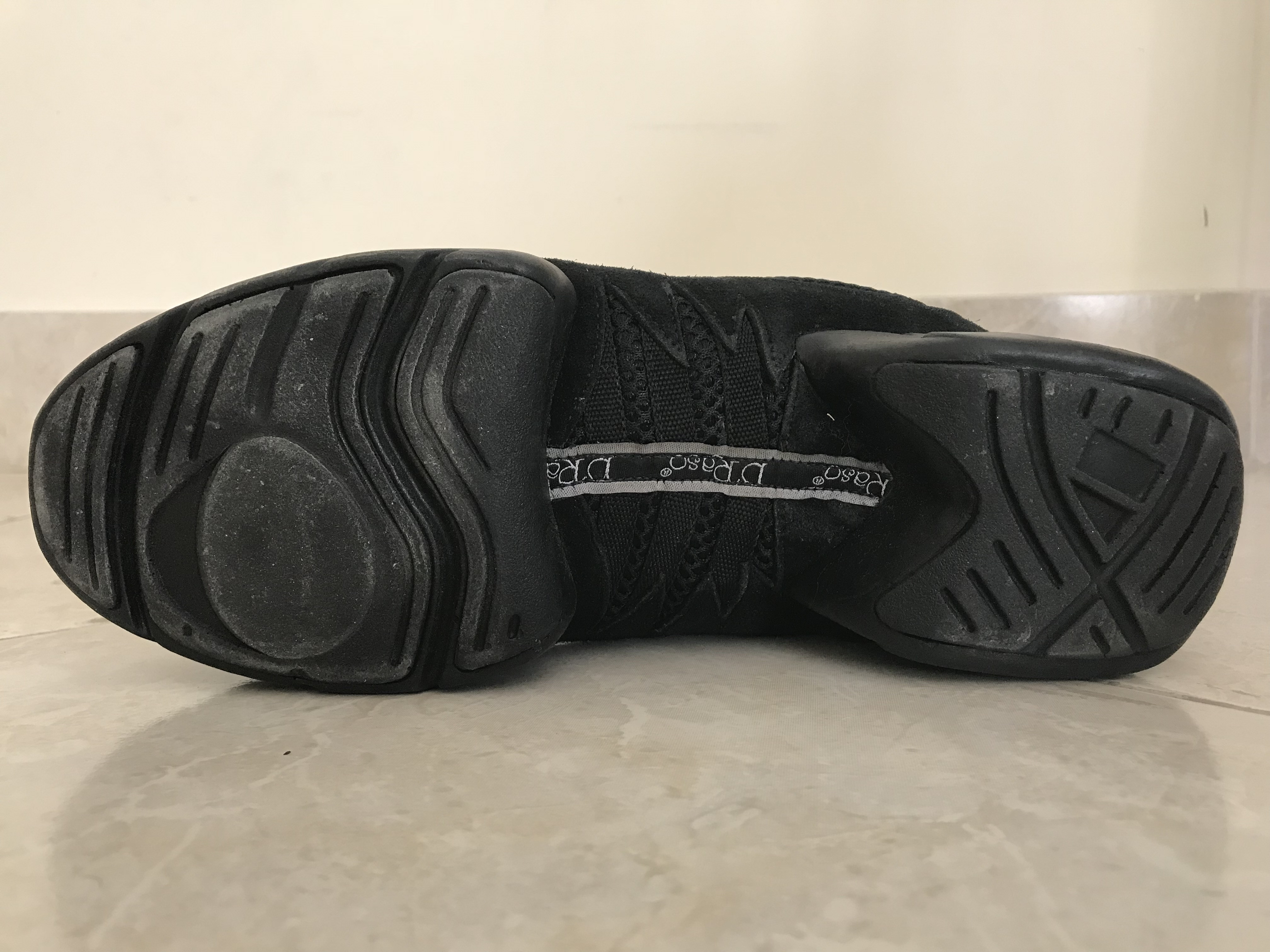 Men’s Dance Sneaker Sole
Men’s Dance Sneaker Sole
Latin Dance Shoes (with Heels)
Latin dance shoes, characterized by their heeled design and suede soles, are specifically engineered for Latin dances like salsa, bachata, and cha-cha-cha.
Pros:
- Enhanced Spin and Glide: The suede sole is designed for maximum slip, making spins and turns effortless on the dance floor.
- Improved Posture and Form: The heel in Latin dance shoes encourages a forward weight distribution, promoting better posture and engaging the core, which instructors often emphasize for proper dance form.
- Dressy and Formal Look: Latin dance shoes are typically crafted from dressier materials like leather or synthetic leather, making them suitable for formal dance events and performances.
- Statement of a Serious Dancer: Wearing Latin dance shoes often signals a commitment to dance and a more serious approach to the art form.
Cons:
- Comfort Challenges: The heeled design, while beneficial for dance form, can be uncomfortable for extended periods, especially for those not accustomed to heels. Toes can feel cramped, and foot fatigue can set in more quickly.
- Lack of Versatility: Latin dance shoes are strictly dance shoes. The suede soles are delicate and not suitable for outdoor wear or even walking on rough surfaces. They are designed to be worn exclusively on the dance floor.
- Requires Carrying Extra Shoes: Due to their specialized nature, you’ll need to carry Latin dance shoes separately and change into them at the dance venue.
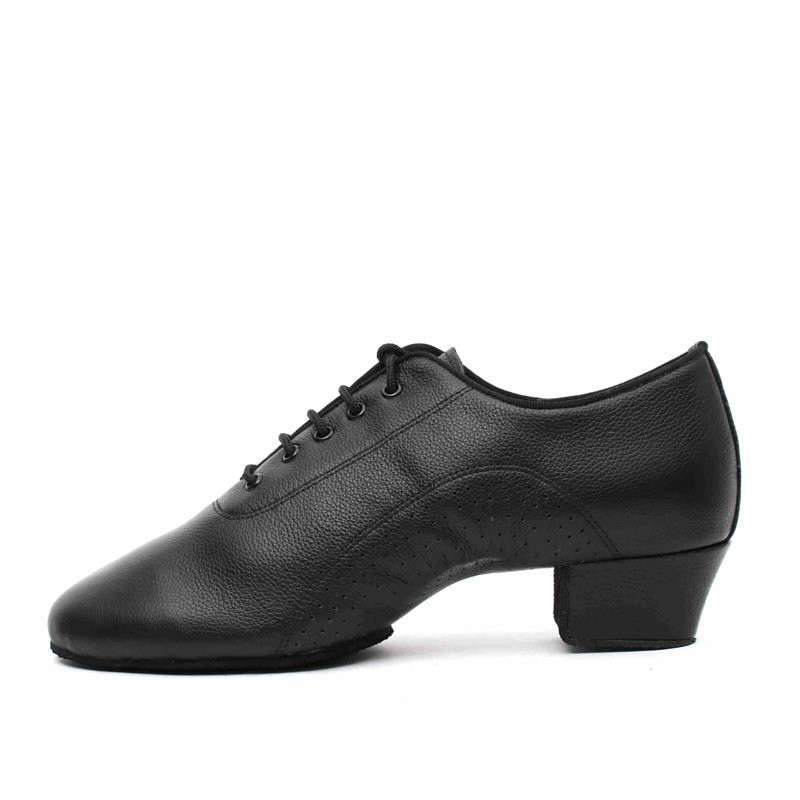 Men’s Latin Dance Shoe Profile
Men’s Latin Dance Shoe Profile
Jazz Shoes
Jazz shoes are another lightweight and flexible option favored by some dancers, particularly for practice and styles that emphasize foot articulation.
Pros:
- Extremely Lightweight and Flexible: Jazz shoes are designed to be almost like a second skin, offering maximum flexibility and allowing dancers to feel very connected to the floor.
- Excellent for Spins and Turns: The suede or split-sole design facilitates easy spinning and smooth movements across the floor.
- Closest Feel to Barefoot Dancing: Jazz shoes provide the most minimal barrier between your feet and the floor, offering a very natural feel, which is beneficial for practicing technique and footwork.
- Affordable: Jazz shoes are generally more budget-friendly compared to other specialized dance shoes.
Cons:
- Lack of Support: The minimal design offers very little arch support or cushioning, which might not be suitable for dancers needing more support or for long dance sessions.
- Not Durable for Outdoor Wear: Similar to Latin dance shoes, jazz shoes with suede soles are strictly indoor dance shoes. The soles are easily damaged by outdoor surfaces or moisture.
- Limited Style Versatility: Jazz shoes have a very specific, minimalist look that is not typically considered stylish for social settings outside of dance studios or performances.
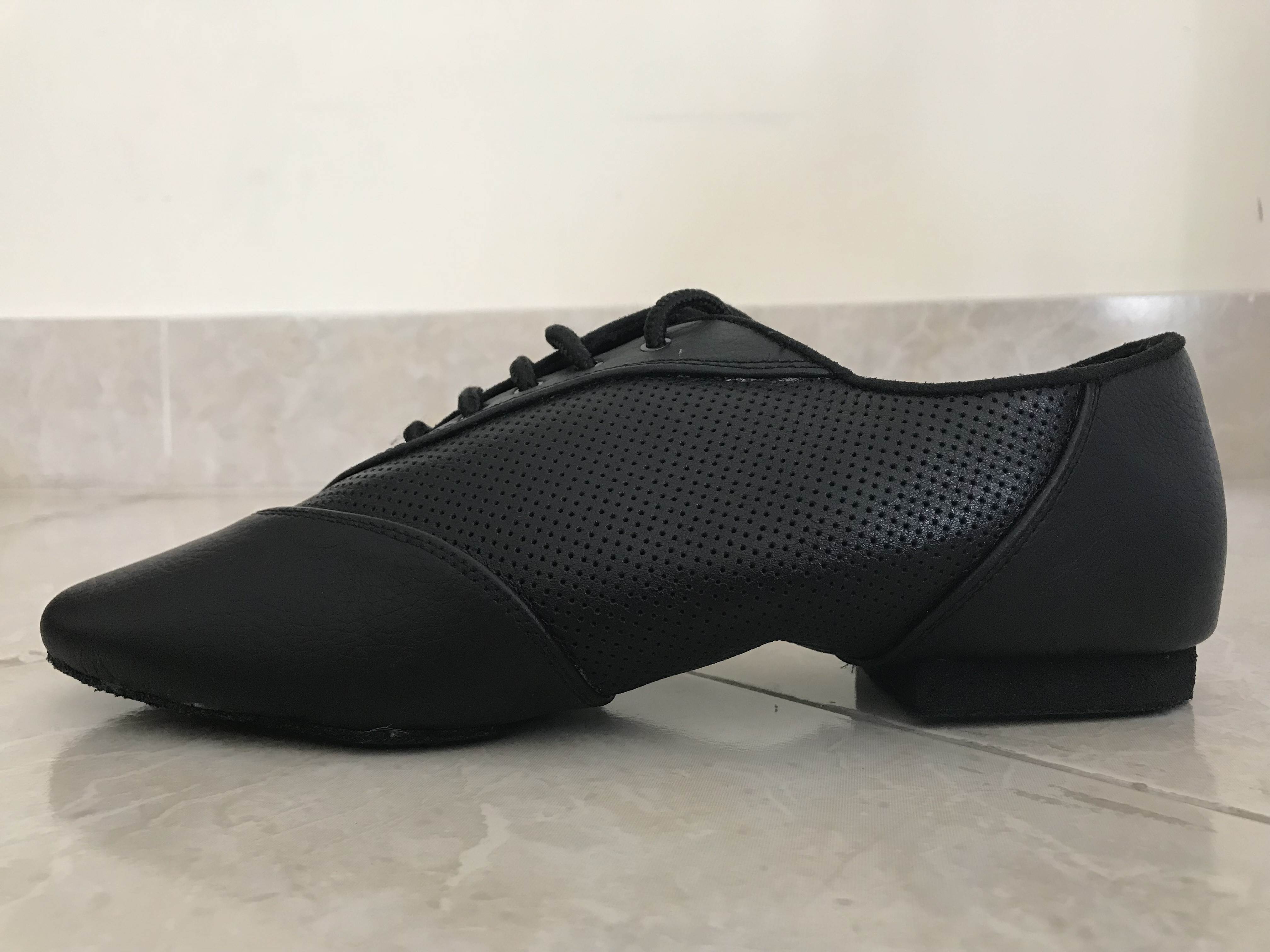 Men’s Jazz Shoe Profile
Men’s Jazz Shoe Profile
 Men’s Jazz Shoe Sole
Men’s Jazz Shoe Sole
Running Shoes
While primarily designed for athletic activities, running shoes are sometimes used by beginner dancers, especially for their comfort and support.
Pros:
- Maximum Comfort and Cushioning: Running shoes are engineered for impact absorption and long-distance comfort, providing excellent cushioning and support for your feet.
- Durable and Supportive: Built for running and high-impact activities, they offer good durability and stability.
- Versatile for Everyday Wear: Running shoes are designed to be worn for various activities and are perfectly acceptable for casual social settings outside of dancing.
Cons:
- High Grip Soles Hinder Spinning: The rubber outsoles of running shoes are designed for traction, which makes spinning and turning difficult and can put stress on your ankles and knees on a dance floor.
- Thick Soles Reduce Floor Feel: The thick, cushioned soles isolate your feet from the dance floor, reducing your ability to feel the ground and make precise movements.
- Clunky Appearance: Some running shoes, especially those designed for maximum cushioning, can appear bulky and less streamlined, which might not be the most stylish option for dancing.
 Men’s Running Shoe Profile
Men’s Running Shoe Profile
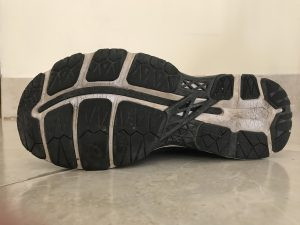 Men’s Running Shoe Sole
Men’s Running Shoe Sole
Sneakers (Casual Street Shoes)
Casual sneakers, like Converse, Vans, or similar styles, are a popular choice for social dancing due to their blend of style, comfort, and a degree of dance-friendliness.
Pros:
- Stylish and Versatile: Sneakers are fashionable and can be paired with various outfits, making them suitable for wearing to dance venues and other social settings.
- Lightweight and Comfortable: Many sneaker styles are lightweight and comfortable enough for extended wear and dancing.
- Some Offer Decent Spin: Sneakers with smoother synthetic or rubber outsoles can provide a reasonable amount of slip for spins and turns, especially compared to high-grip running shoes.
- No Need to Carry Extra Shoes: Their versatility means you can wear sneakers all day and directly onto the dance floor without needing to change shoes.
Cons:
- Inconsistent Sole Performance: The outsole material and grip can vary significantly between sneaker brands and styles. Some may be too sticky, while others may be suitable for dancing.
- Limited Support: Casual sneakers generally offer less arch support and cushioning compared to dedicated athletic or dance shoes.
- Durability Concerns for Dance Use: Frequent dancing can wear down the soles and construction of casual sneakers more quickly than shoes specifically designed for dance.
- Casual Style Not Suitable for Formal Events: Sneakers are generally too casual for very formal dance events or dress codes.
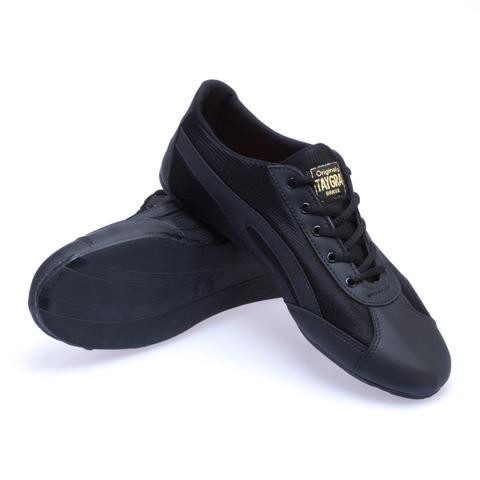 Men’s Casual Sneakers – Taygras
Men’s Casual Sneakers – Taygras
Formal Dress Shoes
The quest for dress shoes that double as dance shoes is ongoing for many men who want a seamless transition from work or formal events to the dance floor.
Pros:
- Formal and Professional Appearance: Dress shoes are essential for work, formal events, and any situation requiring a polished look.
- Potential Versatility (If Suitable for Dancing): Finding dress shoes that are also comfortable and functional for dancing would eliminate the need for extra shoes and simplify your day.
- Leather or Suede Soles (in some styles): Some dress shoes feature leather or even suede outsoles, which can offer good slip for dancing on certain surfaces.
Cons:
- Typically Stiff and Uncomfortable for Dancing: Most traditional dress shoes are designed with stiff soles and materials that are not conducive to the flexibility and movement required for dancing.
- Lack of Flexibility and Floor Feel: The rigid construction often hinders foot articulation and reduces the dancer’s ability to feel connected to the floor.
- Ankle Discomfort and Potential for Injury: Stiff dress shoes can rub against the ankles, causing discomfort or even cuts, especially during dance movements.
- Durability Concerns for Dance Use: Dress shoes not designed for dance can wear out quickly if used frequently on the dance floor.
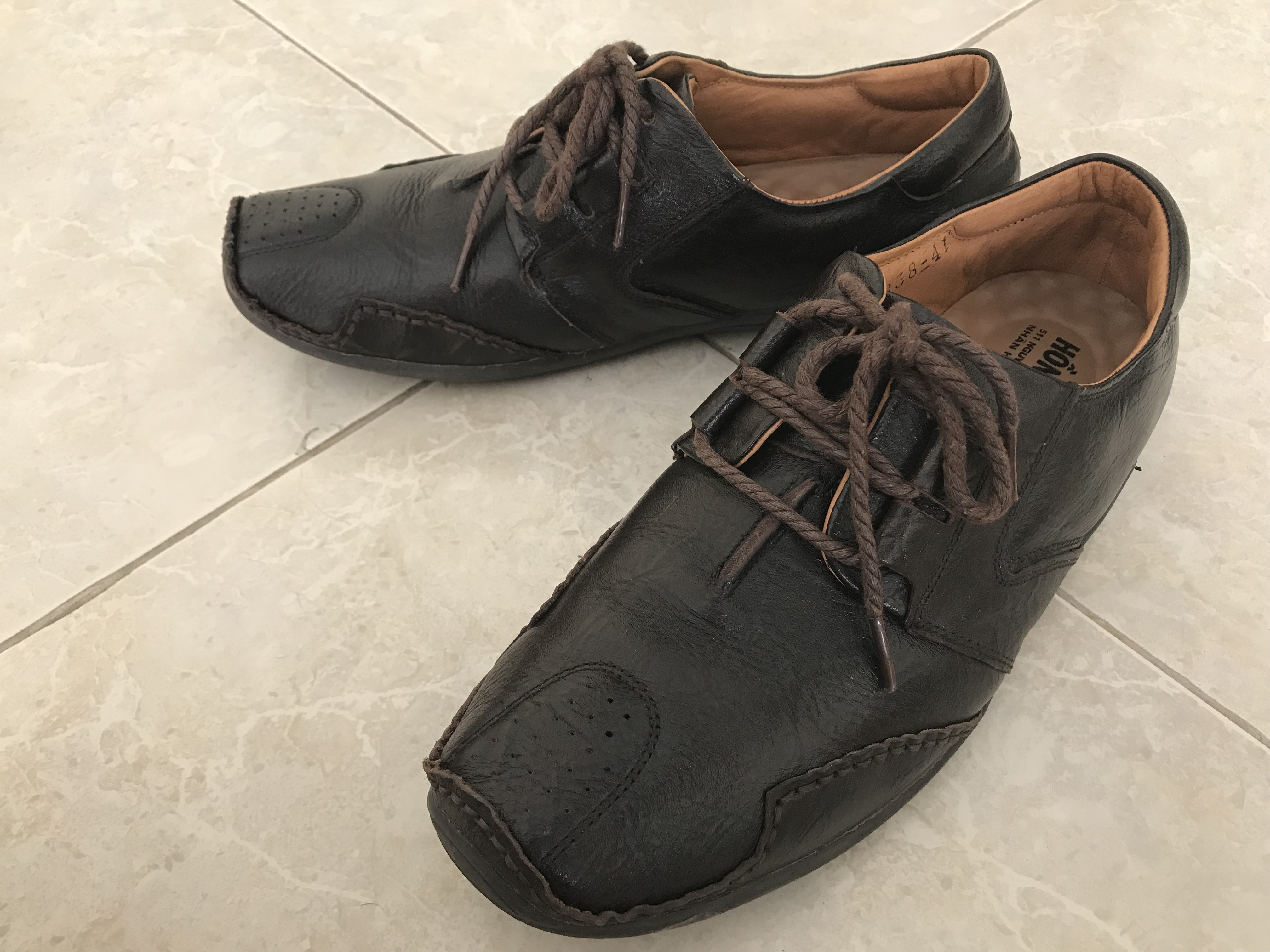 Men’s Leather Dress Shoes
Men’s Leather Dress Shoes
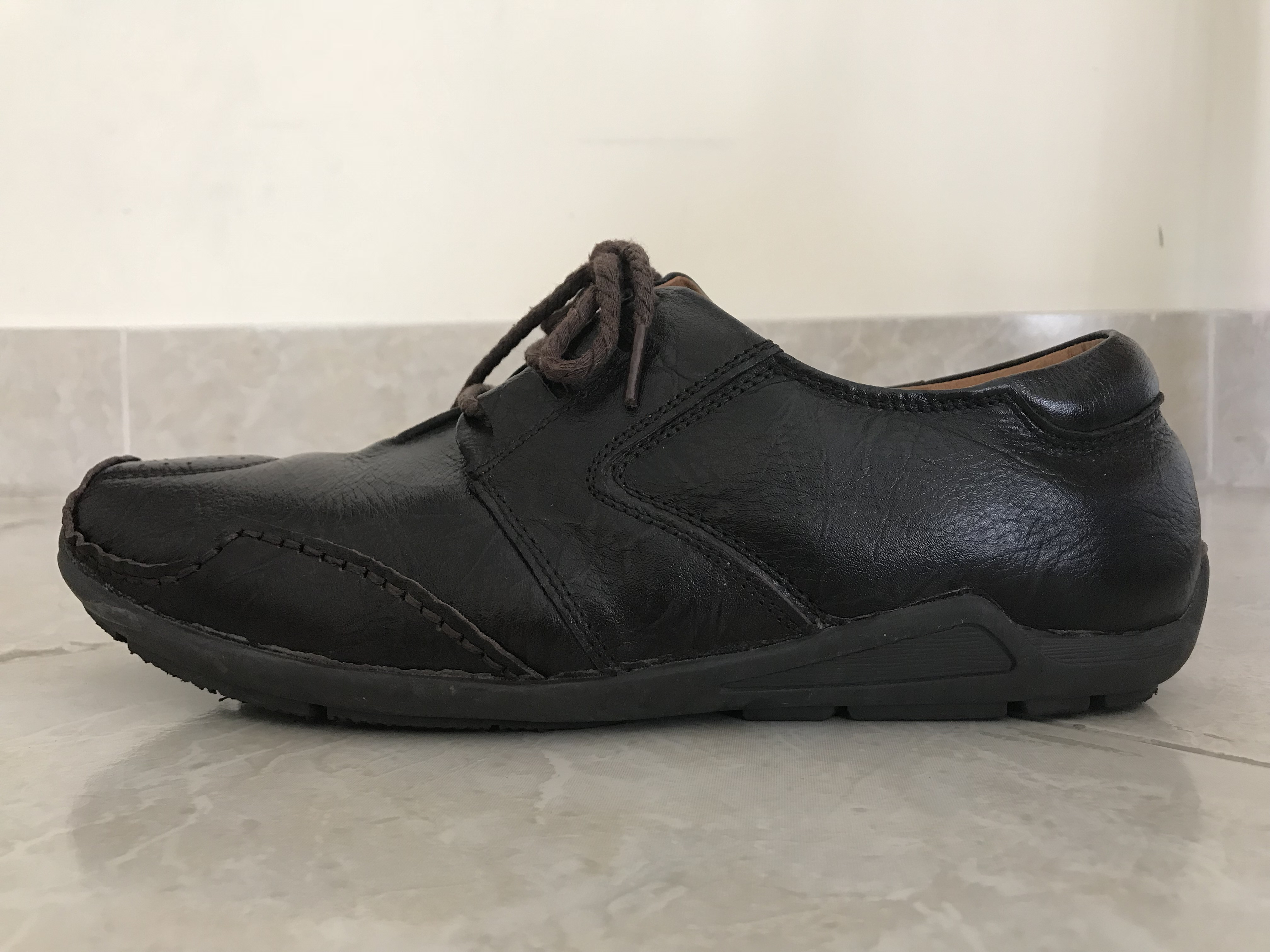 Men’s Leather Dress Shoe Profile
Men’s Leather Dress Shoe Profile
Making the Right Choice: Recommendations and DIY Tips
Ultimately, the “best” dancing shoes for men depend on individual needs, dance style, frequency of dancing, and personal preferences.
For Practice: Jazz shoes are often the most economical and practical choice for practice sessions, especially at home or in a studio with a smooth floor. They offer excellent floor feel and flexibility at a low cost. If carrying extra shoes is inconvenient, running shoes or sneakers can be alternatives, but be mindful of their grip if practicing spins.
For Social Dancing: Sneakers strike a good balance for social dancing, offering style, comfort, and reasonable dance performance. They are versatile enough to wear before, during, and after dancing without needing to change. For those prioritizing comfort, running shoes with smoother outsoles can be a backup, but be aware of the spin limitations.
For Formal Dance Nights: Well-fitting and broken-in dress shoes are suitable for formal occasions. Latin dance shoes are also an option for serious dancers, but require carrying an extra pair. Consider the dance floor surface and the formality of the event when making your choice.
DIY Tip: Know Your Dance Floor Before investing heavily in specialized dance shoes, observe the dance floor surfaces at your regular venues. Different materials (wood, ceramic, vinyl, etc.) can affect shoe performance. A smooth synthetic outsole is generally the most versatile for various dance floor types.
Finding Your Perfect Dance Shoe: A Wishlist for the Ideal Salsa and Bachata Shoe
The ideal dancing shoe for salsa and bachata, and potentially other dance styles, would encompass these features:
- Stylish and Versatile Design: Easy to pair with different outfits and suitable for both dance floors and everyday wear.
- Lightweight Construction: Minimizes foot fatigue and enhances agility for intricate footwork.
- Snug and Contoured Fit: Hugs the foot securely without feeling clunky or loose, maximizing control and responsiveness.
- Thin Sole for Optimal Floor Feel: Allows for better connection with the dance floor and quicker reactions to movements.
- Encourages Ball-of-Foot Dancing: Design and construction naturally promote dancing on the balls of the feet, essential for many dance styles.
- Cushioning and Flexibility: Provides a balance of cushioning for comfort and flexibility for natural foot movement and energy return.
- Smooth Outsole for Easy Spinning: Enables effortless spins and turns on various dance floor surfaces.
- Versatile Outsole Material: Suitable for indoor and outdoor wear, adapting to different weather conditions and surfaces.
- Dual-Purpose for Work and Play: Seamlessly transitions from professional settings to the dance floor, eliminating the need for multiple pairs of shoes.
The search for the “holy grail” of dancing shoes for men is a personal journey. By understanding the different types of shoes available, their pros and cons, and considering your own needs and preferences, you can find the perfect pair to enhance your dance experience and express your style on the dance floor. Explore different options, experiment, and don’t hesitate to ask for recommendations from fellow dancers and instructors to continue your dance shoe journey.
